6172RB Science a STEM approach Year 2 low res watermark
You also want an ePaper? Increase the reach of your titles
YUMPU automatically turns print PDFs into web optimized ePapers that Google loves.
Chemical sciences<br />
LIVING IN A MATERIAL WORLD<br />
Lesson 1<br />
Lesson plan<br />
Introduction:<br />
1. Display a selection of objects at the front of the classroom for students to discuss (see Resources).<br />
What are materials? What materials are these objects made from? How would you describe them?<br />
What are properties of materials? In small groups, students spend five minutes, using<br />
page 44 to list as much as they know about materials. QP PA<br />
Development:<br />
2. What properties do materials have? As a class, watch the video Properties of materials at . Discuss what objects are made from the materials mentioned in the video;<br />
i.e. glass, water, kitchen film, wool, sandpaper, steel, rubber, nylon. Discuss the properties of these<br />
and of a towel vs sandpaper. PC<br />
3. Set up eight stations with one object made from a different material at each station, for small<br />
groups to rotate around. Each station will also require a cup of water with a dropper in it so<br />
students can test the properties of being waterproof or absorbent. Provide students with a copy of<br />
page 45 to complete individually. PC PA<br />
Differentiation<br />
• Less capable students can simply place a tick or cross on the observation sheet.<br />
• More capable students can be encouraged to write additional descriptive words, rather than just<br />
placing a tick or cross.<br />
4. As a class, discuss what materials students observed and which would be best to build a raft or<br />
boat. Which materials float? Which materials could be used for a sail? What properties does a sail<br />
need to have? What could you make a mast from? Why? PC PA<br />
Reflection:<br />
5. As a class, discuss the materials and properties of the objects from each station and compare<br />
<strong>res</strong>ponses. E C<br />
6. Compare observations with their initial thoughts from the beginning of the lesson. Students can<br />
add anything they may have learnt to the page. Why do we need different materials? What other<br />
things can be made from the materials you observed? PA C<br />
© R.I.C. Publications<br />
Low <strong>res</strong>olution display copy<br />
R.I.C. Publications® – www.ricpublications.com.au 978-1-925431-95-7 YEAR <strong>Science</strong>:<br />
2 A <strong>STEM</strong> APPROACH 43


















